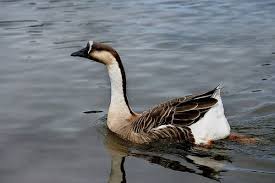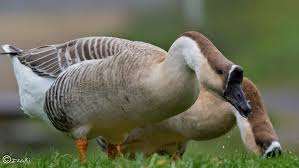The swan goose is a rare large goose with a natural breeding range in inland Mongolia, northernmost China,
and southeastern Russia. It is migratory and winters mainly in central and eastern China. Vagrant birds are
encountered in Japan and Korea (where it used to winter in numbers when it was more common), and more rarely
in Kazakhstan, Laos, coastal Siberia, Taiwan, Thailand and Uzbekistan.
While uncommon in the wild, this species has been domesticated. Introduced and feral populations of its
domestic breeds occur in many places outside its natural range. The wild form is also kept in collections,
and escapes are not unusual amongst feral flocks of other Anser and Branta geese.
Description
The swan goose is large and long-necked for its genus, wild birds being 81-94 cm (32-37 in) long
(the longest Anser goose) and weighing 2.8-3.5 kg (6.2-7.7 lb) or more (the second-heaviest Anser, after
the greylag goose, A. anser). The sexes are similar, although the male is larger, with a proportionally
longer bill and neck; in fact the largest females are barely as large as the smallest males. Typical
measurements of the wing are 45-46 cm (18-18 in) in males, 37.5-44 cm (14.8-17.3 in) in females; the bill
is about 8.7-9.8 cm (3.4-3.9 in) long in males and 7.5-8.5 cm (3.0-3.3 in) in females. The tarsus of males
measures around 8.1 cm (3.2 in). The wingspan of adult geese is 160-185 cm (63-73 in).
The upperparts are greyish-brown, with thin light fringes to the larger feathers and a maroon hindneck and
cap (reaching just below the eye). The remiges are blackish, as are the entire underwing and the white-tipped
rectrices, while the upper- and undertail coverts are white. A thin white stripe surrounds the bill base.
Apart from darker streaks on the belly and flanks, the underside is pale buff, being especially light on
the lower head and foreneck which are sharply delimited against the maroon. In flight, the wings appear
dark, with no conspicuous pattern. Uniquely among its genus, the long, heavy bill is completely black; the
legs and feet, on the other hand, are orange as in most of its relatives. The eyes' irides are maroon.
Juveniles are duller than adult birds, and lack the white bill base and dark streaks on the underside.
The voice is a loud drawn-out and ascending honking aang. As a warning call, a similar but more barking
honk is given two or three times in short succession.
The karyotype of the swan goose is 2n=80, consisting of four pairs of macrochromosomes, pairs of
microchromosomes, and a pair of sex chromosomes. The two largest macrochromosome pairs as well as the Z
(female) chromosome are submetacentric, while the third-largest chromosome pair is acrocentric and the
fourth-largest is metacentric. The W chromosomes are acrocentric too, as are the larger microchromosomes,
the smaller ones probably being telocentric. Compared to the greylag goose, there seems to have been some
rearrangement on the fourth-largest chromosome pair.
Breeding
In April, the Swan geese return from their wintering ranges, for the breeding season with nesting activities
usually occurring in May.
Their nesting habitats are the taiga and mountain valleys near freshwater. Single pairs or loose groups are
found near marshes and other wetlands.
The average clutch consists of 5 - 6 eggs, but sometimes as many as 8 are laid. The shallow nest, made from
plants, is placed directly on the ground.
The eggs are incubated for about 28 days to hatching.
Swan geese leave their nesting territories around late August or early September for their wintering ranges.
The young reach reproductive maturity when they are about 2 - 3 years old.
Diet
Swan Geese are often seen grazing on plains and stubble fields on plants, such as sedges
(Cyperaceae).
Ducks and geese generally feed on larvae and pupae usually found under rocks, aquatic animals, plant
material, seeds, small fish, snails and crabs.
Range
The swan goose can be found throughout southeastern Russia, Mongolia, China, North Korea and South Korea.
Habitat
The species lives on steppe wetlands, lakes and fast-flowing rivers.







